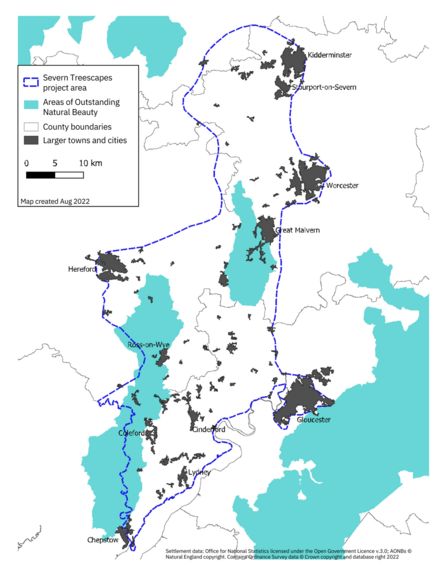Curious to find out more about where the trees are going or how you can get involved?
Read our frequently asked questions below.
What land does the project cover?

Severn Treescapes project area
What advice will be offered and to who?
Arrange a visit with the Severn Treescapes Tree and Woodland Advisors to discuss how you could incorporate more trees into your land to shade livestock, reduce soil erosion, provide buffers to watercourses, and improve connectivity for wildlife, or how to manage existing trees and woodland.
They can also offer suggestions for how to access funding for tree planting schemes including woodlands, hedgerows, wood pastures, parklands, tradition orchards and agroforestry, or to deliver management and protection.
There are a range of schemes available for small and larger planting including RPA and non-RPA schemes.
They can also put you in touch with other relevant organisations who can advise on the other aspects such as wood products.
I’m a landowner – how can I get involved?
Contact our Trees and Woodland Advisors Laurence.richards@gloucestershirewildlifetrust.co.uk or Charlotte.Vincent@Gloucestershirewildlifetrust.co.uk for information on:
- Available tree and woodland grant schemes including Countryside Stewardship, England Woodland Creation Offer, Severn Trent Commonwealth Games Legacy Forest Funding, Green Finance Initiatives and more
- Incorporating more trees into your farming system, for example through hedgerows, wood pastures, parklands, traditional orchards, agroforestry, shelter belts, small or larger woodland creation
- Woodlands that you would like to get a management grant for
- Planting or creating a new woodland
- To talk to someone about the potential that your land holds for incorporating more trees
How can communities get involved?
Community groups and schools might be interested to join in our seed to sapling initiative, where we will be running events to collect local native tree seeds. The groups can then grow them in pots in back gardens until local planting sites are available.
For seed collection and events, please contact our Community Engagement Coordinator - megan.finn@gloucestershirewidlifetrust.co.uk
How can parish and town councils get involved?
Parish and town councils may be looking for advice on planting community woodlands or orchards, or just adding a few key trees to local greenspaces, while local communities could be interested in growing those trees to be planted in local locations.
The Severn Treescapes team can help to identify suitable planting sites, provide advice on tree planting grants and help the community to collect and grow native tree seed for local plantings - a great way to engage children with their community and develop an appreciation of and responsibility for their local environment.
For planting, management and grants advice, please contact our Trees and Woodland Advisors laurence.richards@gloucestershirewildlifetrust.co.uk or Charlotte.Vincent@Gloucestershirewildlifetrust.co.uk.
For seed collection and events, please contact our Community Engagement Coordinator megan.finn@gloucestershirewidlifetrust.co.uk
What if I live in or own land that isn’t in Gloucestershire or overlaps its boundary?
The project is working across three neighbouring counties. If you own land that isn't in Gloucestershire or overlaps any county boundaries, you can find more local information on the following websites.
Herefordshire Wildlife Trust Worcestershire Wildlife Trust
Who are the project partners?
Our partners for this project are:
- Gloucestershire County Council
- Herefordshire Council
- Worcestershire County Council
- Severn Trent Water
- Environment Agency
- BBC Radio Gloucester Ourboretum
What are some native tree species that are suitable for growing?
Common beech, Fagus sylvatica
Blackthorn, Prunus spinosa
Bird cherry, Prunus padus
Wild cherry, Prunus avium
Field maple, Acer campestre
Hawthorn, Crataegus monogyna
Hazel, Corylus avellana
Hornbeam, Carpinus betulus
Large-leaved lime, Tilia platyphyllos
Small-leaved lime, Tilia cordata
Sessile oak, Quercus petraea
Common or English oak, Quercus robur
Rowan, Sorbus aucuparia
Spindle, Euonymus europaeus
Sweet chestnut, Castanea sativa
Common walnut, Juglans regia
Wild service tree, Sorbus torminalis
Whitebeam, Sorbus aria
This useful guide from the Woodland Trust will help you identify trees throughout the year.
The content on this webpage, except the images, is available to use through Creative Commons 4.0. The photos have been generously donated to the Trust for us to use to promote our work, they are not available for third party use.


